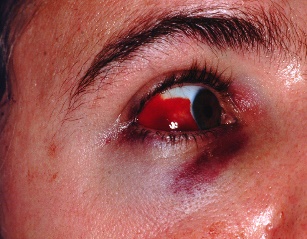Zygomatic fractures



Signs and symptoms of zygomatic fractures:
- Peri-orbital ecchymosis/haematoma/bruising
- Epistaxis
- Subconjunctival haemorrhage
- Diplopia
- En/Exophthalmos
- Infra-orbital anaesthesia or paraesthesia
- Deformity
- Restricted mandibular movements (if the TMJ is restricted under a fractured zygomatic arch)
- Subcutaneous emphysema
Le Fort/Middle third injuries
There are 3 levels of Le Fort middle third facial fractures I-III, with increasing mid face bony instability. For practical purposes the exact type of middle third fracture is not important as all will need review by a maxillofacial specialist, usually after review in an Emergency Department.
In order to assess for a middle third facial fracture, hold the nasal bones with the thumb and index finger of one hand and the upper jaw/maxilla with the thumb and index finger of the other (finger on the palatal side and thumb on the buccal side of the front teeth area. Attempt to gently move the hand holding the upper jaw/maxilla over the anterior teeth area, back and forward (anterior/posterior), remove any mouthguard or denture first. If the hand holding the upper jaw/maxilla moves then the upper jaw is broken and this is a Le Fort/middle third facial fracture.
Some patients with middle third facial fractures will have paraesthesia or anaesthesia of one or both cheeks.
One uncommon but significant problem with a displaced middle third maxillary fracture is if there is haemorrhage which can difficult to control. If this occurs the maxilla can be reduced by asking the player to bit down on rolled gauze placed between the back teeth of the upper and lower jaw on both sides, if they are unconscious the rolled gauze can be wedged between the upper and lower teeth.




Patients with suspected facial bone fractures should be referred to the local emergency department for further assessment, investigation and treatment.